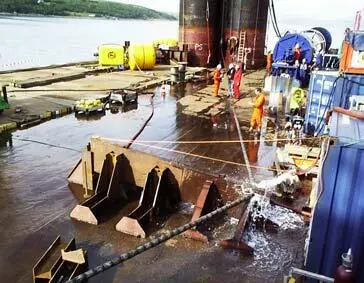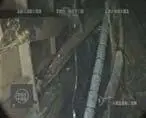Phase 2:Installation of the 26 lifting fittings, the lowering through the pre-inserted tubes in the barge hull and connecting of 26 sets of lifting cables, each comprising 54 strands of seven twisted wires each 6mm diameter and the raising of the Kursk using Mammoet’s strand jack system. The cables would then hold the Kursk against a pre-fitted inverted cradle under the barge during transit to a floating dock near Murmansk.
Phase 3:The fitting of two large pontoons, one under each side of the barge, to lift it entirely out of the water to give sufficient clearance of the underslung Kursk over the cradles when entering the floating dock, the lowering of the Kursk onto the cradles, followed by demobilization and withdrawal of all M-S equipment and personnel.
Severing the remains of № 1 compartment deployed a heavy cable carrying thick-walled tubular sections coated with a very coarse (~25mm) abrasive. Reciprocating motion was to be provided by two 30 tonne hydraulic rams attached by suction anchors to the seabed.


The cable cutting rig trials on Giant 4 suction anchors (top) acting against an opposite set actual underwater cutting (inset)
The strand jack system relies on two collets on each strand, the upper collets being hydraulically lifted/lowered as a cable group. Additional hydraulics activate the collets under computer control, the timing of the collet activation determining whether the strands are raised or lowered. Each cable lifting system was to be supported by four pneumatic cylinders with 4m strokes and with a large nitrogen gas reservoir, the pressure being matched to the cable load so that large movements due to swell (within the cylinder stroke limits) would have minimal effect on the cable loads.


The strand jack (inset [a small picture]) mounted within the cable reel platform with the swell compensator rams underneath
NUCLEAR & RADIOLOGICAL SAFETY
In early June, Large & Associates were engaged by M-S to complete a preliminary assessment of the nuclear hazard and held a number of meetings with RUBIN to discuss and determine the information and data likely to be made available from the RF authorities with respect to radiation and nuclear safety issues. On the basis of this information, Large & Associates was instructed to form and head up the Nuclear Coordinating Group (NCG).
The NCG was headed by John Large of Large & Associates with members Peter Davidson of the UK National Nuclear Corporation (NNC) and Commander Huw Jones of the Royal Navy’s Naval Nuclear Regulatory Panel. Later Alan Martin of Alan Marin Associates was seconded onto the NCG to organize the radiological management regime for the recovery spread (the salvage boats). The NCG had direct access to other consultants in the explosive, weapons and salvage fields. John Large also represented and negotiated with the insurers on behalf of Mammoet-Smit for personnel and equipment cover that was ticketed across a number of underwriters at Lloyds, the United States and Russia.
The role of the NCG was to review and evaluate all relevant aspects of nuclear and radiological safety arising from the M-S recovery operations for all stages of the recovery.
The first task was to ascertain what parts of a nuclear safety case were already in place and evaluate them. It quickly became apparent that there was no structured case in existence on which to build.
The RF approach to safety was essentially deterministic. Any probabilistic treatment was limited to confirming that sequences outside the design basis (which was itself not comprehensively defined) were sufficiently unlikely (e.g. with an annual probability of less than 10 -7). There seems to have been no overall integration of the diverse range of technologies covering nuclear propulsion, weapons systems, life support systems and operational systems, to cover the full spectrum of potential interactions between them. Instead, the strategy seemed to consider deliberately each area in isolation with a definition for each area of a worst-case accident that the other areas must withstand.
The engineering of the Kursk was similarly compartmentalized. This was possibly to minimize the need for detailed interface coverage between the various design bureaus. The flaw in this approach was that there could never have been a full recognition of the wide range of potential challenges, failure modes and consequences (including interactions) arising from internal plant failures and external hazards.
The NCG’s overall strategy was framed to suit the RF approach by:
• Establishing the datum condition of the Kursk taking into account the effects of the explosions and the degradation over a year of submersion.
• Examining the stability and residual strength of the datum condition, including the degree of defense in depth that might remain available for the essential reactor safety functions.
• Framing limits and conditions for the M-S operations to ensure that the residual strength and stability criteria could not be exceeded, nor the defense in depth totally undermined, together with allowance for unwanted interactions.
• Ensuring that there was an adequate radiological safety management regime in place to protect the M-S employees and contractors.
In light of this, the NCG set out to work with teams of RF specialists to check how each system had been and could be affected by events and thus establish the limits and conditions that had to be maintained during the M-S recovery operations. The actual and potential interactions of the many systems involved warranted a strong probabilistic evaluation but this was not favored nor, indeed, practiced by the RF for its own assessment. Instead, the approach of RF analysts and engineers was, predominantly, underpinned by reliance upon passive safeguards (e.g. containment, dormancy, etc.) for which probabilistic treatment is anyway not usually necessary. However, this reliance required, first, an accurate and reliable assessment of each ‘safeguard’, particularly the extent to which it may have sustained damage as a result of the original explosions and, then, an account of the degradation that it may have suffered over the year or more that it was submerged in the Barents Sea. Of particular concern to the NCG was the possibility of the M-S operations triggering a further explosion (of a torpedo or missile), and the potential consequences to the reactor plant and safeguards.
On one hand, all that the RF could offer was its assertion and confidence that the M-S salvage of the Kursk could be undertaken within the RF’s sometimes rather qualitatively defined limits of each of the ‘safeguards’ but, on the other hand, its engineers and technicians were enthusiastically responsive to any demands placed upon them by the NCG, often responding in detail once trust had been established, and explaining their sometimes brilliantly simple solutions to problems, as they were identified.
In the light of this, the NCG had to conclude that it was not in a position to provide a traditional assessment or review but, instead, had to weigh these RF statements to assess whether, when put together, they provided a sufficiently coherent and persuasive safety demonstration. In doing this, the NCG had to rely largely on its own judgment and experience.
Читать дальше
















